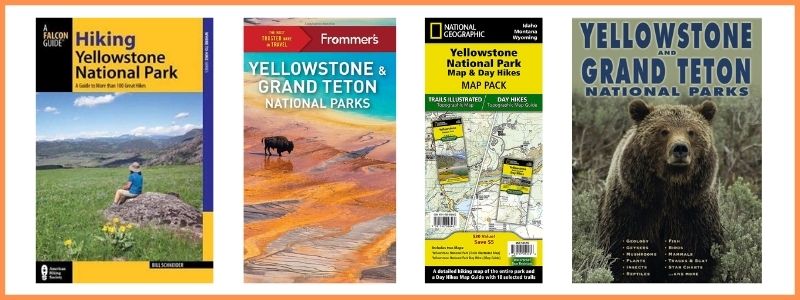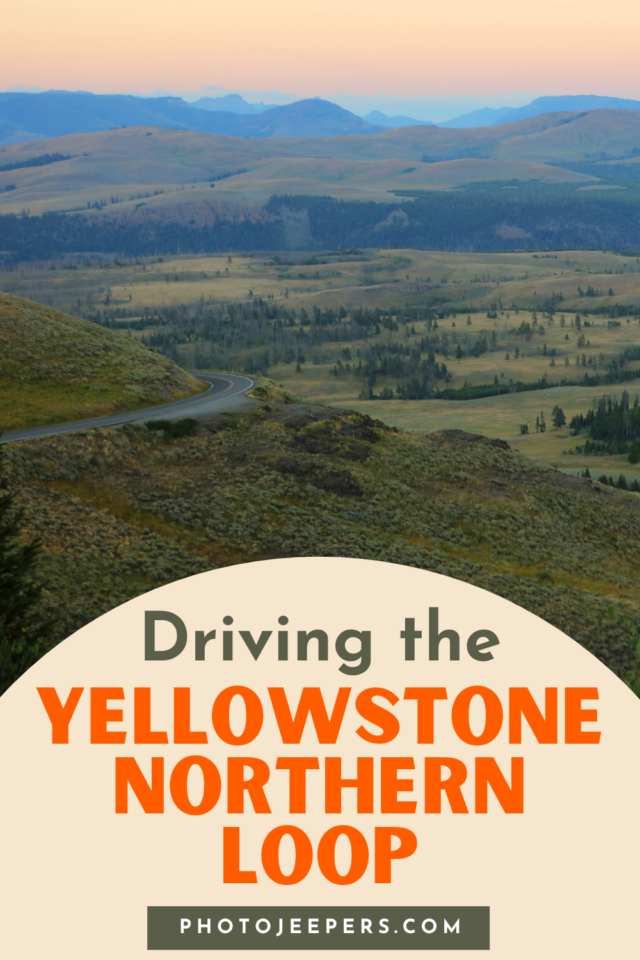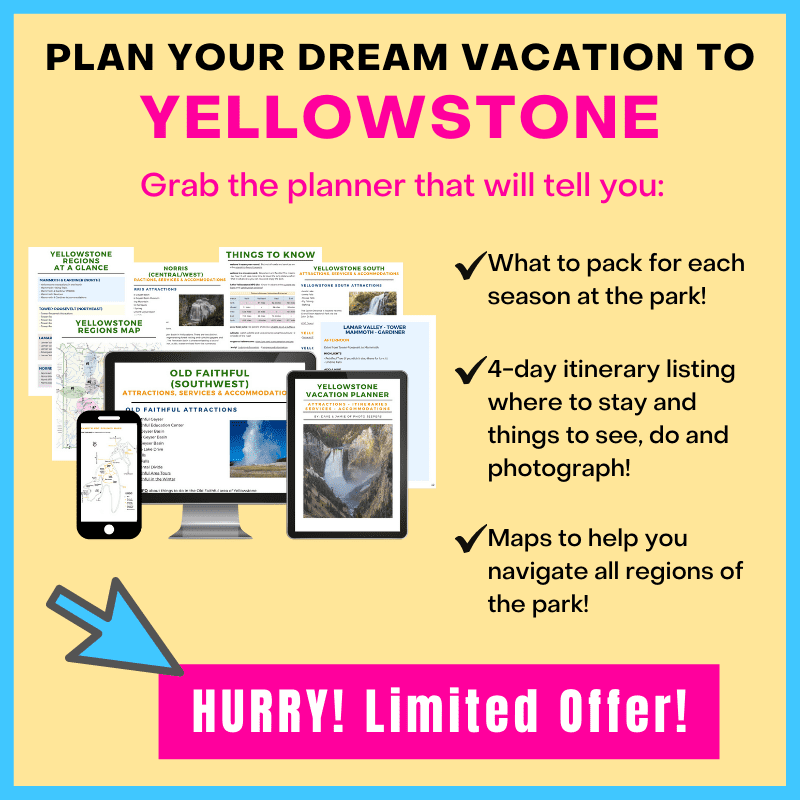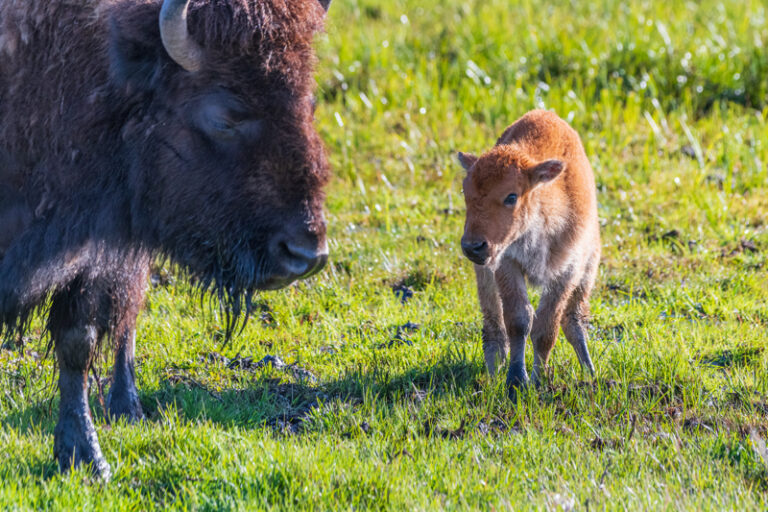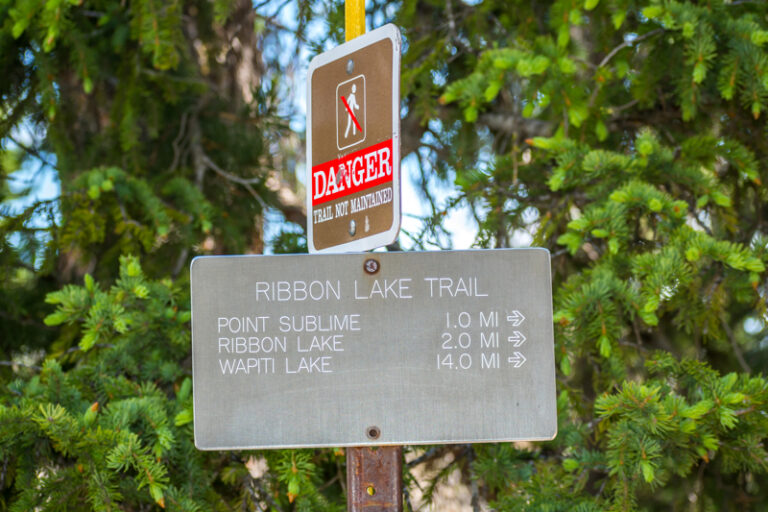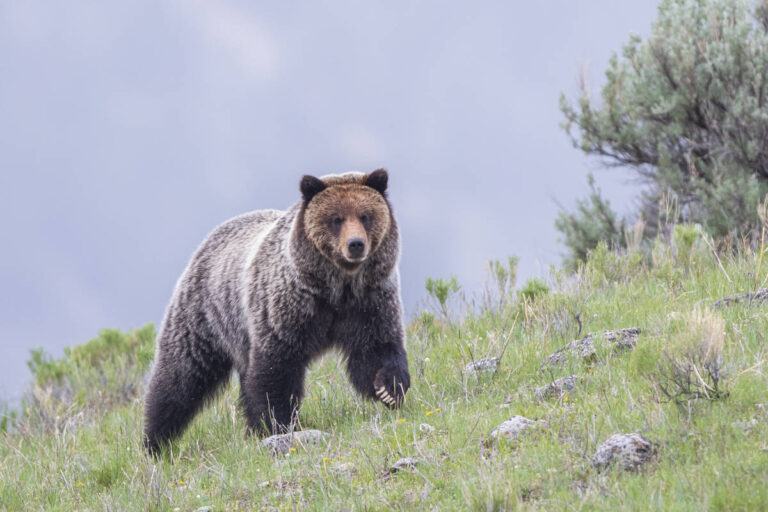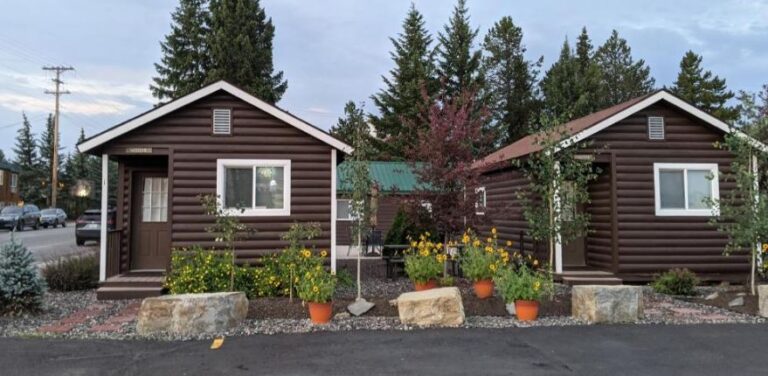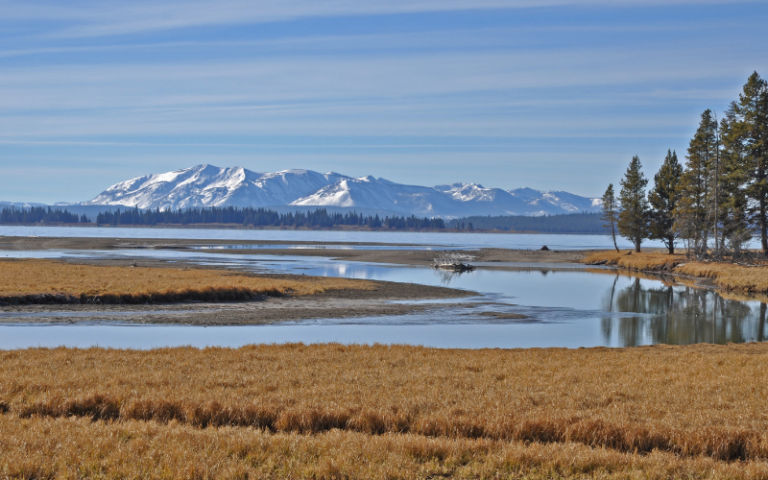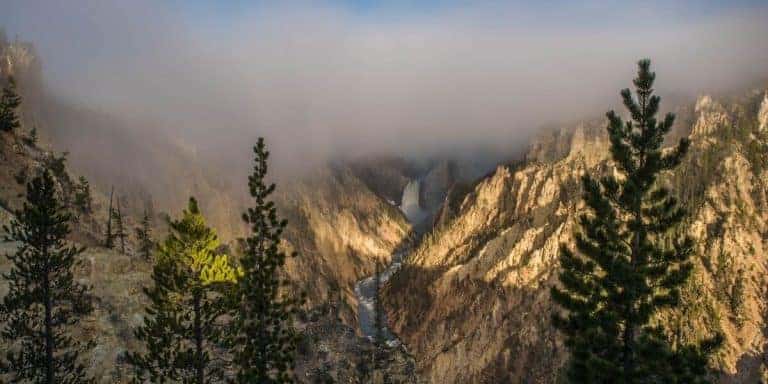Yellowstone National Park Northern Loop: Things to See, Do, and Photograph
Yellowstone covers over 2 million acres of land! It’s divided into 2 main sections and 9 areas. This guide will focus on the Yellowstone National Park Northern Loop: things to see, do, and photograph.
You’ll find everything you need to know in this Yellowstone National Park travel guide: best times to visit, what to pack, where to stay, and things to do!
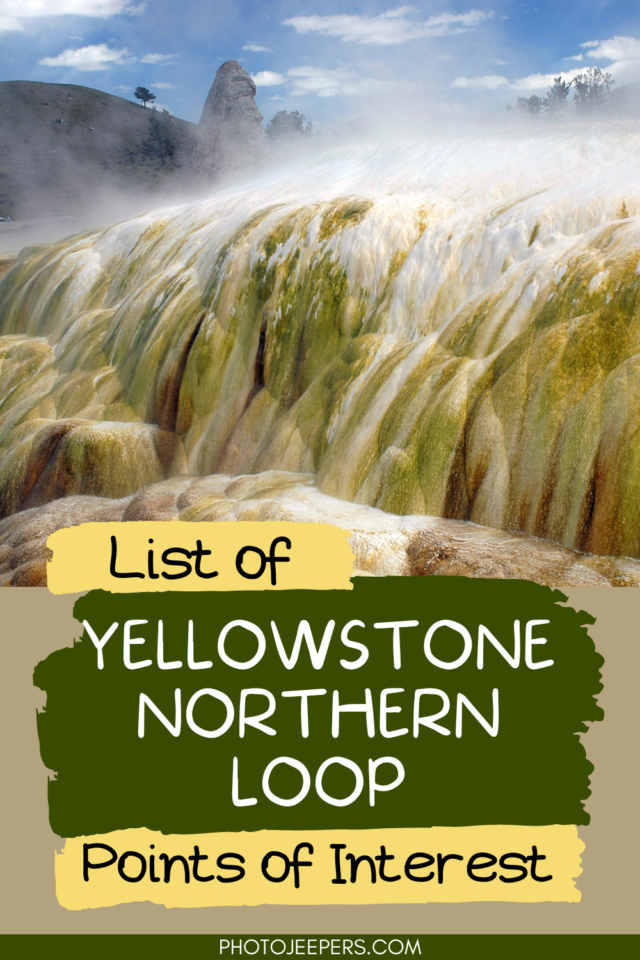
This guide lists all the attractions, hiking trails, services and accommodations found for each area in the Northern Loop of Yellowstone.
Use the information to create a Yellowstone itinerary that’s tailored to what YOU want to see and do!
Grab a copy of the Yellowstone National Park Packing List to make sure you have the right clothing and gear for visiting any time of year. Get your free printable packing checklist by clicking the image below!
This site contains affiliate links which means WE may receive commissions for purchases made through these links. We only provide links to products we actually use and/or wholeheartedly recommend! As an Amazon Associate, we earn from qualifying purchases. Read the full Disclosure Policy.
A Photo Tour of the Yellowstone Northern Loop
Take a visual tour through the Yellowstone Northern Loop to see the stunning wildlife, waterfalls and landscape in this part of the park!
Visiting Yellowstone National Park
Yellowstone is one of the most popular National Parks in the United States. On March 1, 1872 Yellowstone was established as America’s first national park. The park covers an area of 2,219 square miles. The average elevation is 8,180 feet above sea level.
It is famous for its geothermal activity—especially Old Faithful Geyser and Grand Prismatic Spring—and for its large concentration of wildlife.
We visit Yellowstone multiple times a year because we love it that much! Our favorite things to see and photograph are the Yellowstone waterfalls, geysers and wildlife.
Check out our guide detailing the best places to see Wildlife in Yellowstone National Park!
Areas to Visit in the Yellowstone Northern Loop
There are two entrances with direct access to the north loop of Yellowstone: North (Gardiner) and Northeast (Cooke City).
You can use the other three Yellowstone National Park southern loop entrances and drive to the northern loop from West (West Yellowstone), South (Grand Teton), and East (Cody).
There are four areas in the northern loop of Yellowstone:
- Mammoth
- Tower-Roosevelt
- Canyon
- Norris
We detail all the services, lodging, and things to do in each of these areas of Yellowstone in more detail later in this guide.
Best Time to Visit the Northern Loop of Yellowstone
The best time to visit Yellowstone National Park is during one of the park’s shoulder seasons in the spring from April through May, and in the fall from September through October. The park is crowded throughout July and August when most families are on summer vacation.
Additionally, you can further reduce your encounters with park crowds by visiting Yellowstone National Park during nonpeak hours, which are either before 8:00 am or after 3:00 pm.
Our favorite months for a Yellowstone vacation are May, October and during the winter. We think they are the best times to visit yellowstone for wildlife.
- Yellowstone in the Spring
- Yellowstone Summer Vacation
- Yellowstone Vacation in the Fall
- Yellowstone Winter Vacation
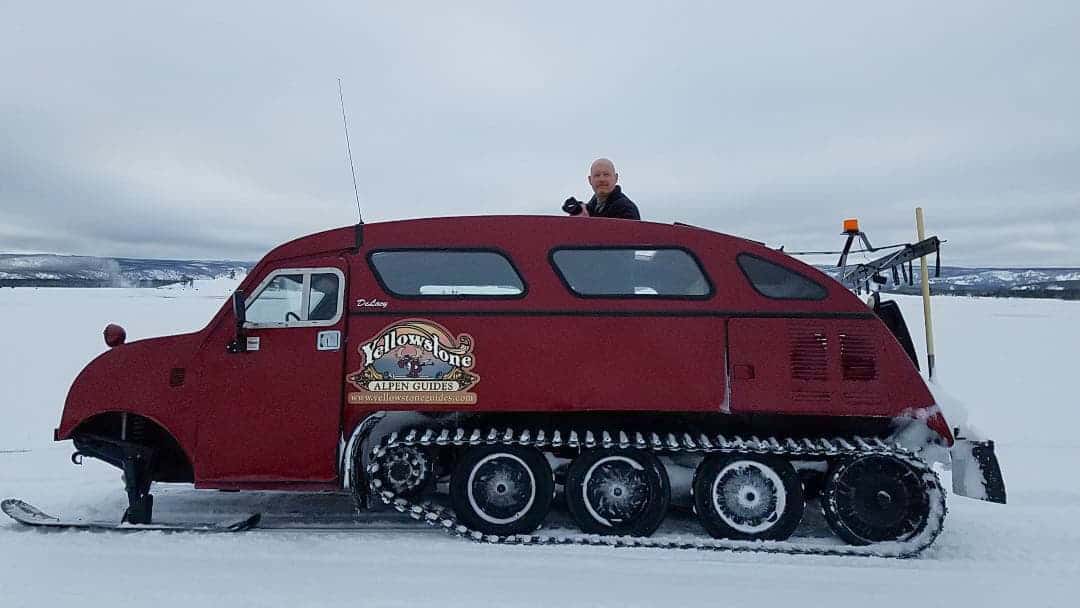
Yellowstone North Loop Operating Hours
Yellowstone National Park is open to visitors 365 days a year, twenty-four hours a day if you use the North Entrance, which is located just outside of Gardiner, Montana. This road is regularly plowed during the winter season and will lead visitors to Cooke City, Montana, and the Northeast section of the park.
The southern loop part of the park is closed throughout November (to prepare for winter) and between the end of March and early April (to prepare for summer).
In mid-December, the roads open to oversnow travel only via snowmobile, snowcoach, snowshoe and cross-country ski. Planning a Yellowstone winter vacation is a unique experience you’ll never forget! We highly recommend Alpen Guides – riding the bombardier snowcoach was amazing!
See the website for specific Yellowstone park roads information. When roads are open they can be used by park guests twenty-four hours a day, seven days a week.
Entrance Fees at Yellowstone
There are a variety of passes available to visit Yellowstone. Check the website for the most current Yellowstone fee prices and information.
If you plan to visit Grand Teton National Park through the south entrance, you will need to purchase a separate admission pass for Yellowstone AND Grand Teton, or purchase the National Parks Pass.
Yellowstone Weather
Since most of the park sits above 6,000 feet (1829 m) in elevation, daily Yellowstone National Park weather patterns can vary unpredictability throughout each month of the year. Therefore, expect significant seasonal changes in temperature, rain, and snow. Accordingly, regardless of when you visit, be sure to pack a fleece jacket, rain gear, and lots of layers.
In spring and fall specifically, daytime temperatures can vary between 30°F and 60°F (0°C to 20°C) in a single day, with overnight lows in the teens and single digits (-5°C to -20°C). Snow is also common throughout these seasons, with accumulations of 12 inches (30.5 cm) in a twenty-four hour period being quite normal.
In contrast, summer, daytime temperatures can often climb as high as 70°F (25°C), and even 80°F (30°C) in lower elevation areas. Nights are also typically cooler, with temperatures that may drop below freezing at higher elevations. Thunderstorms are also common throughout the afternoon.
In winter, park guests can expect average, daytime temperatures between zero and 20°F (-20°C to -5°C), with sub-zero temperatures common throughout the evening. Visitors should also prepare for a signifcant amount of snow, with average snowfall levels around 150 inches (381 cm) per year. However, higher elevations will typically receive twice this amount of snow.
→ Packing for a winter vacation in Yellowstone
Yellowstone Pets Policy
Because of the number of different animal species that are found within Yellowstone National Park, bringing your pet with you can limit the number of activities you can participate in.
Pets are not permitted on boardwalks, hiking trails, in the backcountry, or in thermal areas.
Therefore, if you do decide to bring a pet with you on your Yellowstone vacation, please remember that pets may only accompany people in developed areas and must remain within 100 feet (30.5 meters) of roads, parking areas, and campgrounds at all times.
Pets must also always be physically controlled while in either a car, crate, or on a leash that is no more than six feet long. As a result, pets may not be left unattended or tied to an object at any time.
And while pets may be left in a vehicle for a short period of time, it is recommended that someone stay with the animal to help monitor their continued well being. Owners are also required to pick up after their pets and dispose of their waste.
Yellowstone Goods and Services in the Northern Loop
You’ll want to check the Yellowstone website for the most updated operating times for all services in the park.
Yellowstone Visitor Centers in the North Loop
- Norris Area Museums (The Norris Geyser Basin Museum and the Museum of the National Park Ranger are open daily between late May and late September)
- Albright Visitor Center at Mammoth (open daily, year-round, between 9:00 and 5:00 pm, at Mammoth Hot Springs)
Many of these visitor centers also contain park stores that sell a variety of different souvenirs: books, artwork, and educational materials.
Yellowstone Service Stations in the Northern Loop
These service stations offer 24-hour, year-round, credit card fueling: Mammoth Hot Springs and Tower Junction
Yellowstone North Loop Cell Service
Like most national parks, cellular service is limited in Yellowstone since cell towers are only found at Mammoth Hot Springs and Mount Washburn in the northern park of the park. Service can also be found at the North entrance.
Guests can use free WIFI services at Albright Visitor Center in Mammoth Hot Springs (WIFI is also available at some hotels and lodges around the park).
Yellowstone Medical Services in the North Loop
- Mammoth Clinic
All clinics are open to the public and fully equipped for most medical emergencies and routine care. Services include injury/illness treatment, x-rays, and some lab and pharmacy services. If in-patient care is required, clinic staff can stabilize patients and transfer them to hospitals outside the park.
Miscellaneous Services in the Northern Loop of Yellowstone
- Powell Lock for locksmith services
- US Post Office: Mammoth Hot Springs
For visitor convenience, general stores, gift shops, mini stores, and park stores can be found throughout the park allow visitors to buy a wide variety of gifts, food, and travel essentials.
Check the Yellowstone website for operating hours and seasons for the various services in the park.
Yellowstone National Park Map
Printable and interactive Yellowstone maps will help you navigate through the park.
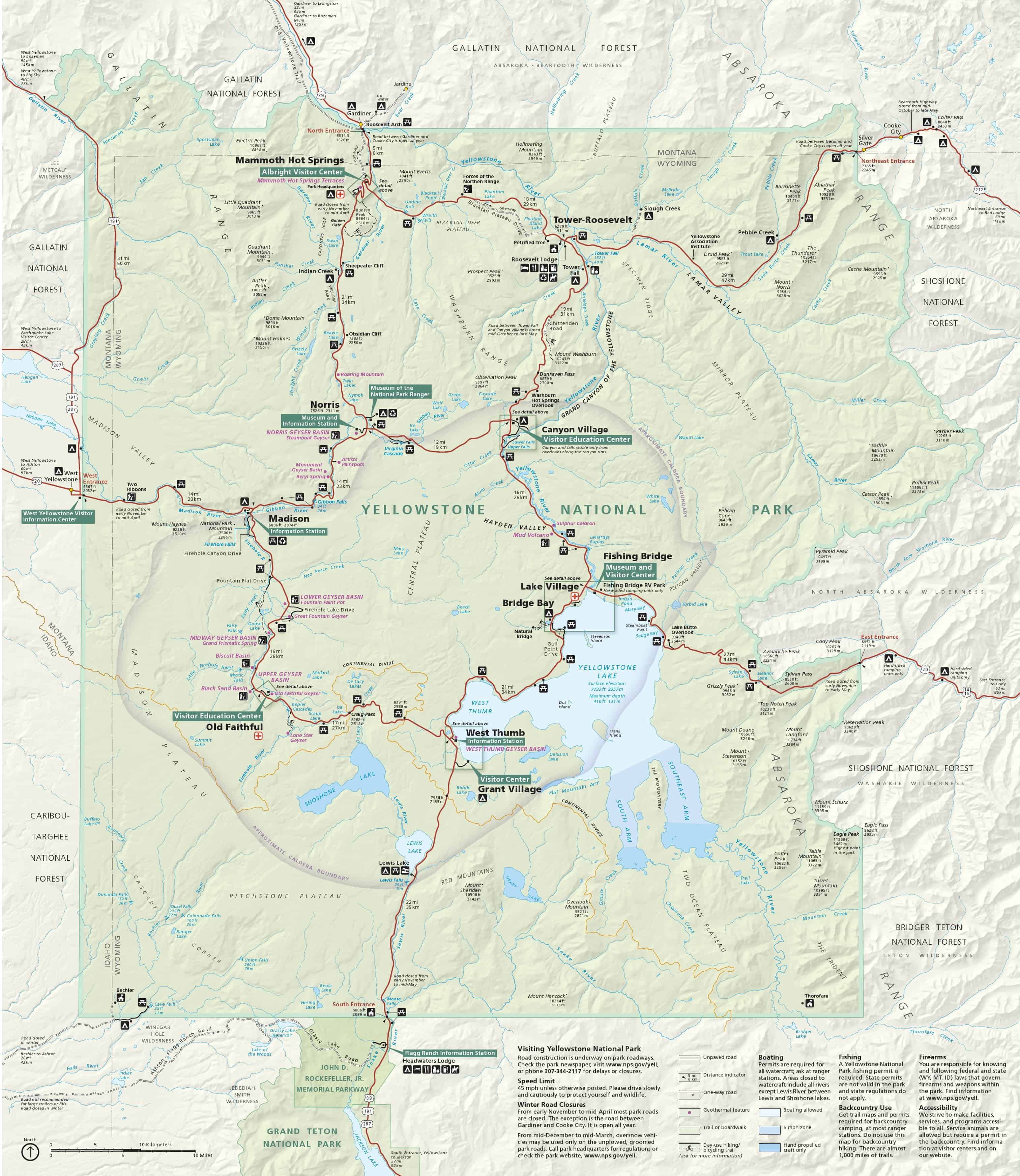
Yellowstone National Park Northern Loop: Things to See, Do, and Photograph
Here’s a list of things to do at Yellowstone National Park to add to your vacation itinerary when visiting the North Loop.
Here are two Northern Loop tours:
We are listing the northern loop points of interest in geographic order starting and ending in Mammoth Hot Springs.
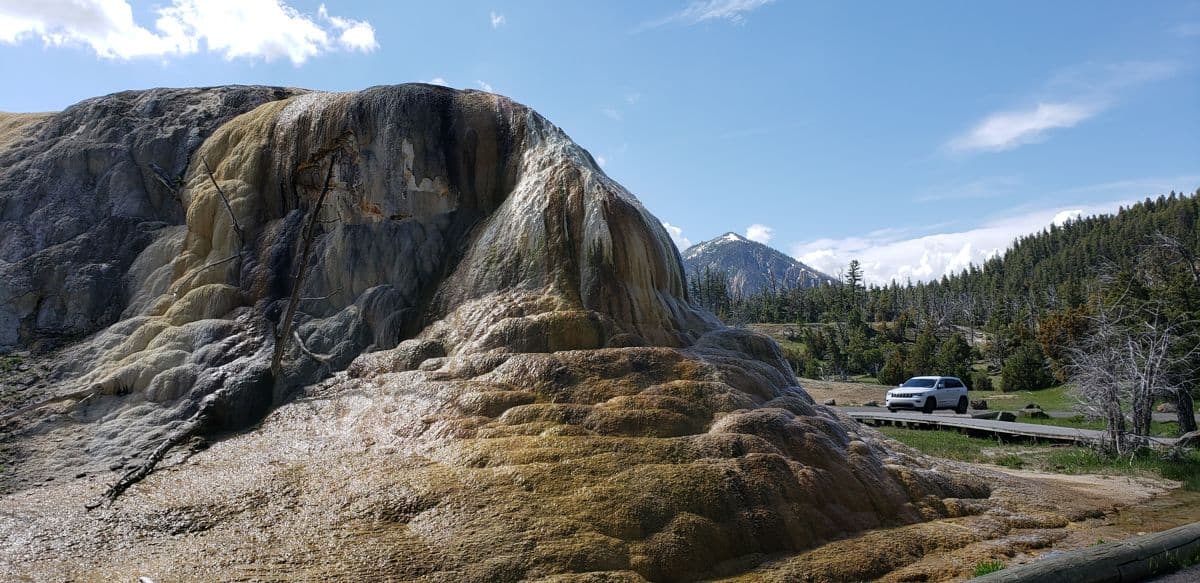
Mammoth Hot Springs & the North Entrance
The North Entrance in Gardiner, Montana is the only one of the five that remains open all year. The town of Gardiner has a variety of accommodation, restaurants, shops, gas stations, a grocery store and more.
One notable historical feature is Roosevelt Arch, which was the main entrance to Yellowstone when it was dedicated in 1903 by the 26th president.
From Gardiner drive toward Mammoth Hot Springs. There are no geysers or large pools in Mammoth. Instead you’ll see warm, subterranean water has created large areas of beautiful terraces. You can see a bit of these terraces from the main highway, but the trails, boardwalks and a one-way loop drive provide better access.
Mammoth is a small town with a hotel, the historic Fort Yellowstone, a visitor center and some shops.
We love to plan our Yellowstone vacation in the fall around the elk rut. It’s amazing to see the elk congregate on the lawns and fields in Mammoth and at the North Entrance.
The Mammoth Hot Springs Hotel is the only place in the northern loop to offer Yellowstone winter lodging.
Mammoth Hot Springs and Gardiner Attractions:
- Roosevelt Arch – Gardiner, MT
- Yellowstone Heritage and Research Center – Gardiner, MT
- Yellowstone Summer Tours – rafting tours in Gardiner, MT
- 45th Parallel
- Albright Visitor Center
- Historic Fort Yellowstone
- Mammoth Hot Springs: Lower & Upper Terrace Drive
- Mammoth Hot Springs Area Day Hikes in Yellowstone
Mammoth and Gardiner Lodging
Our Favorite Places to Stay in Gardiner:
- Yellowstone Gateway Inn, Gardiner – full kitchen and comfy bed, one of our favorite places to stay!
- Park Hotel Yellowstone, Gardiner – charming place to stay and loved by guests!
- Absaroka Lodge, Gardiner – beautiful location with river views!
- Gardiner hotels
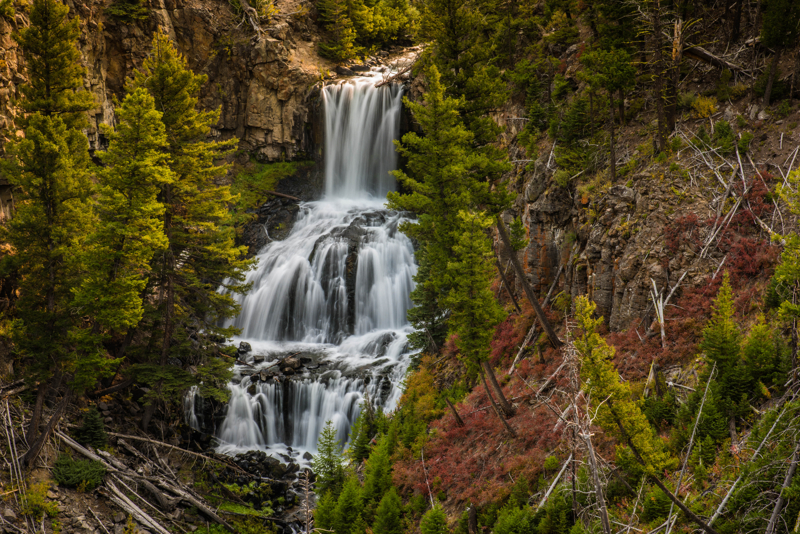
Mammoth to Roosevelt
From Mammoth, drive toward Roosevelt. Along the way you’ll pass Undine Falls, Wraith Falls, Blacktail Plateau Drive, and the Petrified Tree.
If it’s open, we recommend driving Blacktail Plateau Drive, a 6 mile one-way dirt road that takes you off the paved road to experience the solitude of the Yellowstone wilderness. Driving on this road is slower than the main road, which makes it easier to spot the elk, bison and bears in area and enjoy the views.
You’ll find the Roosevelt Lodge, cabins, a store, restaurant, gas station, and horse rentals. One of the fun things to do here is ride out to Yancy’s Hole on a horse or in a covered wagon to enjoy the popular Old West Dinner Cookout.
Roosevelt Area Attractions and Lodging:
- Undine Falls
- Wraith Falls
- Blacktail Plateau Drive
- Petrified Tree
- Lost Creek Falls
- Tower and Northeast Area Day Hikes in Yellowstone
- Tower-Roosevelt Service Station
- Old West Cookout
- Roosevelt Lodge
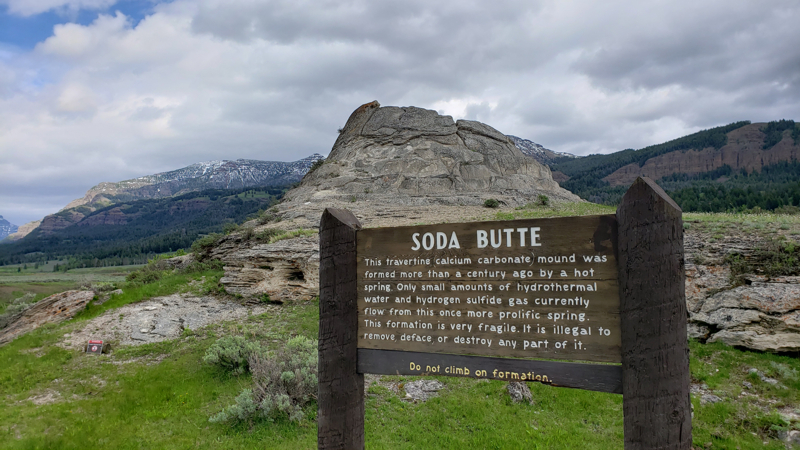
Roosevelt to Lamar Valley & the Northeast Entrance
If you want to see wildlife, add Lamar Valley to your northern loop itinerary. It’s a wide open, grassy expanse which makes it easier to spot wildlife. Bison are most common here, and many hundreds may often be seen, sometimes walking right next to or along the road. But if you’re lucky, you’ll see wolves and grizzly bears. Spring and fall are the best times to visit yellowstone for wildlife.
When you reach the often smelly Soda Butte formation, the road will turn toward the northeast. You’ll travel through beautiful wooded and mountainous landscape and come to the Northeast Entrance.
Past the national park boundary there are two small towns, Silver Gate and Cooke City. There are basic facilities in these towns. The US 212 highway from here begins a long, continuous descent through the Shoshone National Forest.
The road from Gardiner to Cooke City is open year-round. Many people plan their Yellowstone winter vacations based in Gardiner so they can drive through this section of the park in their own vehicle.
Lamar Valley and the Northeast Attractions:
- Yellowstone Association Institute
- Lamar Buffalo Ranch
- Soda Butte
- Pebble Creek
- Ice Box Canyon
- Fly fishing
- Lamar Valley Wildlife Tours
- Cooke City Information Center (public restrooms)
- Cooke City Activities
Lamar Valley and the Northeast Lodging:
Our Favorite Places to Stay in Silver Gate and Cooke City:
- Sunny Log Home on the Creek, Silver Gate (VRBO) – the most AMAZING location with an awesome fireplace and comfy bed!
- High Country Motel and Cabins – local owners who love what they do, and make you feel so welcome!
- MORE Silvergate/Cooke City Hotels
Roosevelt to Tower
From Roosevelt head toward Tower Falls. Hike the short trail to see the 132 foot waterfall. There’s a general store and snack bar here too.
Tower Attractions and Lodging:
- Calcite Spring
- Tower Fall
- Tower Fall Campground
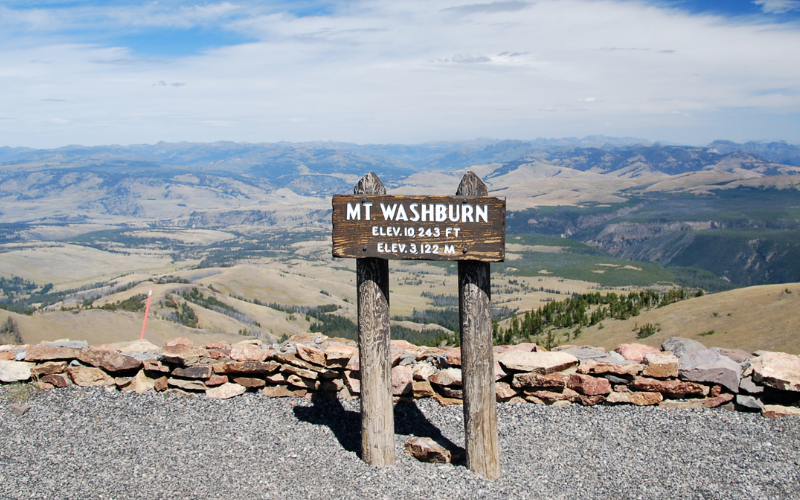
Tower to Canyon
From Tower you’ll drive south along Dunraven Pass over Mount Washburn (10,243 feet). Dunraven Pass (8,859 feet) is the highest road pass in Yellowstone. It can get snow at any time of year, even summer. It may close during a regional snow storm, and it is always the first road to close in the fall as the park prepares for the winter.
This road is the perfect location to view various areas of the park from a high vantage. If you want to get even higher, hike the trail to the summit of Mount Washburn in just a few short miles!
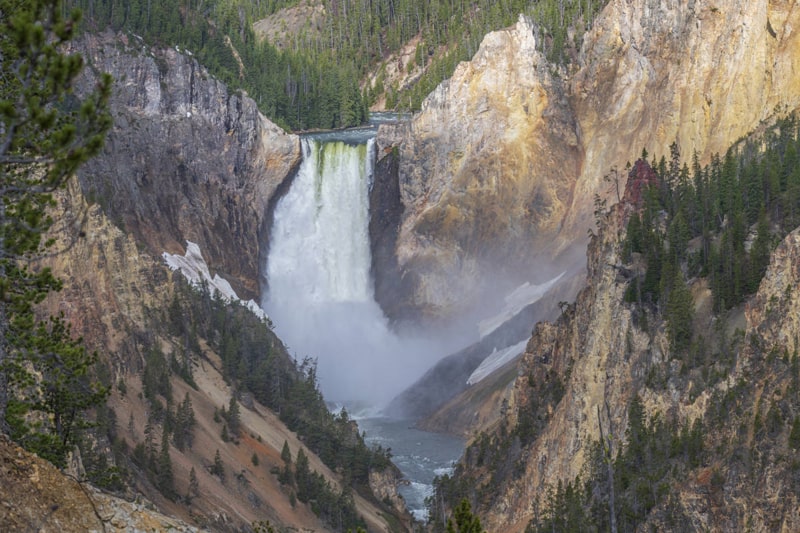
Grand Canyon of the Yellowstone & Canyon Village
The Yellowstone River flows over two large waterfalls and drops into the Grand Canyon of the Yellowstone.
It’s a spectacular canyon with steep walls formed of jagged, eroded, chemically altered volcanic rocks of unusually bright colors – red, pink, orange and white.
Viewpoints for the Upper Falls:
- Upper Falls Trail
- Uncle Tom’s Trail
- Artist Point
North Rim Viewpoints for the Lower Falls:
- Brink of Lower Falls
- Lookout Point
- Red Rock Point
- Grandview Point
- Inspiration Point
Canyon Area Attractions:
- Grand Canyon of the Yellowstone
- Canyon Visitor Education Center
- Canyon Area Day Hikes at Yellowstone
Canyon Area Services and Lodging:
- Canyon Village general store, restaurant, cafeteria, and deli
- Canyon Village gas station
- Canyon Village public restrooms
- Canyon Lodge
- Canyon Campground
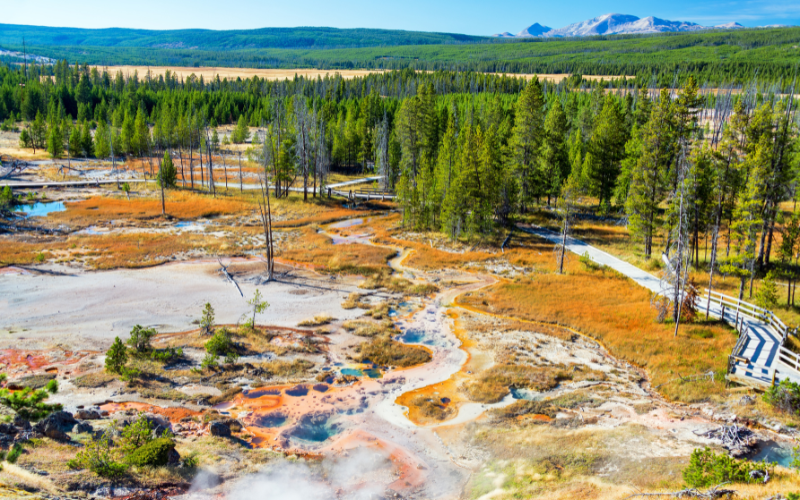
Canyon to Norris
From Canyon to Norris you’ll drive through Gibbon Meadows and find Virginia Cascade. This area is a good place to see wildlife like grizzly bears and elk!
Norris Geyser Basin is the hottest geyser basin in Yellowstone. There are two distinct sections here. The Back Basin is in a regenerating forest setting and contains geysers and hot springs tucked among the trees.
The Porcelain Basin is characterized by a lack of vegetation. No plants can live in the hot, acidic, water emitted from the numerous thermal features in the basin.
You’ll find Steamboat Geyser at Norris. It’s the largest active geyser in the world.
Steamboat can reach 380 feet and its steam phase can be heard miles away.
Unfortunately, Steamboat is rare, and difficult to predict.
Norris Area Attractions and Lodging:
- Gibbon Meadows
- Virginia Cascades
- Norris Geyser Basin
- Norris Geyser Basin Museum
- Museum of the National Park Ranger
- Norris Campground
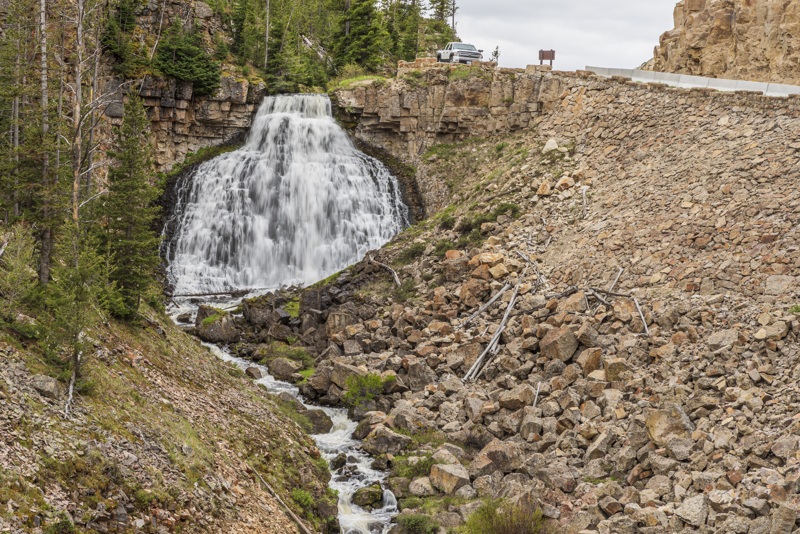
Norris to Mammoth
As you drive from Norris back to Mammoth, you’ll pass Roaring Mountain, Beryl Spring, Obsidian Cliff, Sheepeater Cliffs, Swan Lake Flat, and Rustic Falls.
Watch for grizzly bears and black bears along this drive. The meadow around Swan Lake is a fun place to stop – we’ve seen grizzly bears, elk, and swans here!
Once you leave the open meadow area and head down the mountain toward Mammoth, be sure to pull off at the second turn out on the right. You can’t easily see Rustic Falls as you drive down so you’ll need to stop, get out, and look back to see these pretty falls!
Now you’ve got a general idea of all there is to see along the Yellowstone northern loop!
